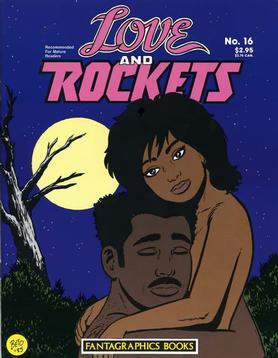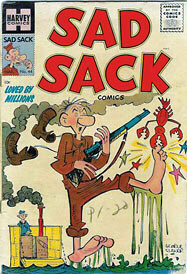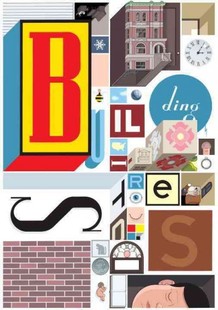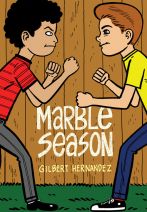Related Research Articles

A comic book, also called comicbook, comic magazine or simply comic, is a publication that consists of comics art in the form of sequential juxtaposed panels that represent individual scenes. Panels are often accompanied by descriptive prose and written narrative, usually, dialogue contained in word balloons emblematic of the comics art form.

Gilberto Hernández, usually credited as Gilbert Hernandez and also by the nickname Beto, is an American cartoonist. He is best known for his Palomar/Heartbreak Soup stories in Love and Rockets, an alternative comic book he shared with his brothers Jaime and Mario.
Image Comics is an American comic book publisher and is the third largest direct market comic book and graphic novel publisher in the industry by market share.

Fantagraphics is an American publisher of alternative comics, classic comic strip anthologies, manga, magazines, graphic novels, and (formerly) the erotic Eros Comix imprint.

Love and Rockets is a comic book series by the Hernandez brothers: Gilbert, Jaime, and Mario. It was one of the first comic books in the alternative comics movement of the 1980s.

A British comic is a periodical published in the United Kingdom that contains comic strips. It is generally referred to as a comic or a comic magazine, and historically as a comic paper. As of 2014, the three longest-running comics of all time were all British.

JaimeHernandez is the co-creator of the alternative comic book Love and Rockets with his brothers Gilbert and Mario.

Harvey Comics was an American comic book publisher, founded in New York City by Alfred Harvey in 1941, after buying out the small publisher Brookwood Publications. His brothers, Robert B. and Leon Harvey, joined shortly after. The company soon got into licensed characters, which, by the 1950s, became the bulk of their output. The artist Warren Kremer was closely associated with the publisher.

Palomar is the title of a graphic novel written and drawn by Gilbert Hernandez and published in 2003 by Fantagraphics Books (ISBN 1-56097-539-3). It collects work previously published within the pages of Love and Rockets. Palomar is the fictional town in Latin America where all the stories presented are set. Palomar was included in Time magazine's Best Comics of 2003 list.
Girlamatic was a webcomic subscription service launched by Joey Manley and Lea Hernandez in March 2003. It was the third online magazine Manley established as part of his Modern Tales family of websites. Girlamatic was created as a place where both female artists and readers could feel comfortable and featured a diverse mix of genres. When the site launched, the most recent webcomic pages and strips were free, and the website's archives were available by subscription. The editorial role was held by Hernandez from 2003 until 2006, when it was taken over by Arcana Jayne-creator Lisa Jonté, one of the site's original artists. In 2009, Girlamatic was relaunched as a free digital magazine, this time edited by Spades-creator Diana McQueen. The archives of the webcomics that ran on Girlamatic remained freely available until the website was discontinued in 2013.

Sad Sack is an American comic strip and comic book character created by Sgt. George Baker during World War II. Set in the United States Army, Sad Sack depicted an otherwise unnamed, lowly private experiencing some of the absurdities and humiliations of military life. The so-called "unnamed private" was actually Ben Schnall, a true-life private in the US Army during World War II, member of Yank magazine and good curmudgeonly friend of Sgt. George Baker. The title was a euphemistic shortening of the military slang "sad sack of shit", common during World War II. The phrase has come to mean "an inept person" or "inept soldier".
Mario Hernandez is an American writer, artist, and sometime publisher of comics. He is one of the Hernandez brothers, along with his younger brothers Gilbert and Jaime, with whom he co-created the acclaimed independent comic book Love and Rockets.

Poison River is a graphic novel by American cartoonist Gilbert Hernandez, published in 1994 after serialization from 1989 to 1993 in the comic book Love and Rockets. The story follows the life of the character Luba from her birth until her arrival in Palomar, the fictional Central American village in which most of Hernandez's stories in Love and Rockets take place.

Building Stories is a 2012 graphic novel by American cartoonist Chris Ware. The unconventional work is made up of fourteen printed works—cloth-bound books, newspapers, broadsheets and flip books—packaged in a boxed set. The work took a decade to complete, and was published by Pantheon Books. The intricate, multilayered stories pivot around an unnamed female protagonist with a missing lower leg. It mainly focuses on her time in a three-story brownstone apartment building in Chicago, but also follows her later in her life as a mother. The parts of the work can be read in any order.
Human Diastrophism, also known as Blood of Palomar, is a graphic novel by American cartoonist Gilbert Hernandez. It appeared in serialized form in the comic book Love and Rockets in 1987–88, and it first appeared in collected form in 1989 in The Complete Love and Rockets, Volume 8: Blood of Palomar. The story tells of a serial killer in the fictional Latin American village of Palomar, and the political and social implications of the insular villagers' growing contact with the outside world.
Julio's Day is a graphic novel by Gilbert Hernandez, serialized in Love and Rockets Volume 2 in 2001–2007 and collected in 2013. It tells the story of a man whose life spans the years 1900 to 2000.

Love and Rockets X is a graphic novel by American cartoonist Gilbert Hernandez. Its serialization ran in the comic book Love and Rockets Vol. 1 #31–39 from 1989 to 1992, and the first collected edition appeared in 1993.

Marble Season is a graphic novel by American cartoonist Gilbert Hernandez, published by Drawn & Quarterly in 2013.
God and Science: Return of the Ti-Girls is a graphic novel by American cartoonist Jaime Hernandez, published in 2012 after serialization in Love and Rockets: New Stories#1–2 in 2008–2009.
Sloth is a graphic novel by American cartoonist Gilbert Hernandez, published by Vertigo in 2006. The story opens with the teenaged Miguel Serra awakening from a year-long coma. The surreal tale unravels as its protagonists delve into the legends of the sleepy suburban town they live in. The book is unrelated to Hernandez's Palomar stories and is the first of Henandez's graphic novel not compiled from smaller parts.
References
Works cited
- Publishers Weekly staff (2013-07-15). "Children of Palomar". Publishers Weekly . Archived from the original on 2013-08-17. Retrieved 2017-08-19.
- Royal, Derek Parker (2013). "Hernandez Brothers: A Selected Bibliography". ImageTexT: Interdisciplinary Comics Studies. 7 (1). University of Florida. ISSN 1549-6732 . Retrieved 2014-11-29.
- Sacks, Jason (2013-08-30). "Review: Children of Palomar is a Fascinatingly Weird Journey to a Familiar Place". Comics Bulletin . Archived from the original on 2015-09-15. Retrieved 2017-08-19.